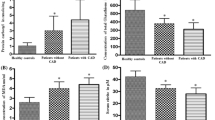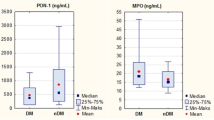Abstract
High density lipoprotein (HDL), a powerful antioxidant, protects low density lipoprotein (LDL) particles against oxidative stress. By limiting LDL oxidation, HDL plays an important role in preventing atherosclerosis (AS). The antioxidant effect of HDL is mostly associated with the paraoxonase (PON1) activity. It has been known that increased aortic intima-media thickness (IMT) is an earlier marker AS than carotid IMT. We aimed to investigate the association between thoracic aortic IMT and serum PON1 activity. We studied 133 patients (mean age: 46.3 ± 8 years) who underwent transesophageal echocardiography (TEE) for various indications. The measurements of thoracic aortic IMT by TEE are classified into four grades (1, 2, 3 and 4). Serum PON1 activity was measured spectrophotometrically. Oxidative and anti-oxidative status was evaluated by measuring serum lipid hydroperoxide (LOOH), total anti-oxidant status (TAS). Serum PON1 activity was progressively decreasing from grade 1 IMT to grade 4 IMT (p < 0.001). However, serum LOOH was significantly lower and TAS was significantly higher in patients with grade 1 when compared with other grades. In multiple linear regression analysis, IMT was independently correlated with PON1 activity (β = −0.495, p < 0.001), TAS level (β = −196, p < 0.009), age (β = 0.145, p = 0.029) and LDL cholesterol level (β = 0.169, p = 0.009). Decreased PON1 activity was independently associated with the extent of thoracic AS. PON1 activity may play a role in pathogenesis of thoracic AS besides age, TAS and LDL cholesterol levels.




Similar content being viewed by others
References
Barter PJ, Nicholls S, Rye KA et al (2004) Antiinflammatory properties of HDL. Circ Res 95:764–772
Mineo C, Deguchi H, Griffin JH et al (2006) Endothelial and antithrombotic actions of HDL. Circ Res 98:1352–1364
Mackness MI, Durrington PN, Mackness B (2000) How high-density lipoprotein protects against the effects of lipid peroxidation. Curr Opin Lipidol 11:383–388
Soran H, Younis NN, Charlton-Menys V et al (2009) Variation in paraoxonase-1 activity and atherosclerosis. Curr Opin Lipidol 20:265–274
Soran H, Hama S, Yadav R, Durrington PN (2012) HDL functionality. Curr Opin Lipidol 23:353–366
Mackness MI, Arrol S, Abbott C et al (1993) Protection of low-density lipoprotein against oxidative modification by high density lipoprotein associated paraoxonase. Atherosclerosis 104:129–135
Mackness B, Durrington PN, Mackness MI (2002) The paraoxonase gene family and coronary heart disease. Curr Opin Lipidol 13:357–362
Gur M, Aslan M, Yildiz A et al (2006) Paraoxonase and arylesterase activities in coronary artery disease. Eur J Clin Invest 36:779–787
Sarkar PD, TMS, Madhusudhan B (2006) Association between paraoxonase activity and lipid levels in patients with premature coronary artery disease. Clin Chim Acta 373:77-81
Hung CL, Po HL, Liu CC, Yen CH, Wu YJ, Hou CJ, Kuo JY, Yeh HI, Su S (2013) The utilization of carotid artery imaging beyond metabolic scores and high-sensitivity CRP in screening intermediate-to-high Framingham risk of asymptomatic Taiwanese population. Int J Cardiovasc Imaging 29(4):765–775
Ko GT, Chow CC, Leung G, Au-Yeung TW, Chan WB, Lam CS, Lo M, Lee KK (2011) High rate of increased carotid intima-media thickness and atherosclerotic plaques in Chinese asymptomatic subjects with central obesity. Int J Cardiovasc Imaging 27(6):833–841
Tribouilloy C, Shen WF, Peltier M et al (1994) Noninvasive prediction of coronary artery disease by transesophageal echocardiographic detection of thoracic aortic plaque in valvular heart disease. Am J Cardiol 74:258–260
Harrington J, Peña AS, Gent R et al (2010) Aortic intima media thickness is an early marker of atherosclerosis in children with type 1 diabetes mellitus. J Pediatr 156:237–241
Teichholz LE, Kreulen T, Herman MV et al (1976) Problems in echocardiographic volume determinations: echocardiographic–angiographic correlations in the presence of absence of asynergy. Am J Cardiol 37:7–11
Eckerson HW, Wyte CM, La Du BN (1983) The human serum paraoxonase/arylesterase polymorphism. Am J Hum Genet 35:1126–1138
Erel O (2004) A novel automated method to measure total antioxidant response against potent free radical reactions. Clin Biochem 37:112–119
Arab K, Steghens JP (2004) Plasma lipid hydroperoxides measurement by an automated xylenol orange method. Anal Biochem 325:158–163
Sentí M, Tomás M, Fitó M et al (2003) Antioxidant paraoxonase 1 activity in the metabolic syndrome. J Clin Endocrinol Metab 88:5422–5426
Aviram M, Rosenblat M, Bisgaier CL, Newton RS, Primo-Parmo SL, La Du BN (1998) Paraoxonase inhibits high-density lipoprotein oxidation and preserves its functions. A possible peroxidative role for paraoxonase. J Clin Invest 101:1581–1590
Tartan Z, Orhan G, Kasikçioglu H et al (2007) The role of paraoxonase (PON) enzyme in the extent and severity of the coronary artery disease in type-2 diabetic patients. Heart Vessels 22:158–164
Demirbag R, Yilmaz R, Kunt AS et al (2006) Relationship between plasma total antioxidant capacity and thoracic aortic intima-media thickness. Echocardiography 23:183–188
Serdar Z, Aslan K, Dirican M et al (2006) Lipid and protein oxidation and antioxidant status in patients with angiographically proven coronary artery disease. Clin Biochem 39:794–803
Navab M, Hama SY, Van Lenten BJ et al (1997) Mildly oxidized LDL induced an increased apolipoprotein J/paraoxonase ratio. J Clin Invest 99:2005–2020
Aviram M, Rosenblat M, Billecke S et al (1999) Human serum paraoxonase (PON 1) is inactivated by oxidized low density lipoprotein and preserved by antioxidants. Free Radic Biol Med 26:892–904
Van Lenten BJ, Navab M, Shih D et al (2001) The role of high-density lipoproteins in oxidation and inflammation. Trends Cardiovasc Med 11:155–161
Ansell BJ, Fonarow GC, Fogelman AM (2007) The paradox of dysfunctional high-density lipoprotein. Curr Opin Lipidol 18:427–434
Ansell BJ, Fonarow GC, Fogelman AM (2006) High-density lipoprotein: is it always atheroprotective? Curr Atheroscler Rep 8:405–411
Navab M, Anantharamaiah GM, Fogelman AM (2005) The role of high-density lipoprotein in inflammation. Trends Cardiovasc Med 15:158–161
Novak F, Vavrova L, Kodydkova J et al (2010) Decreased paraoxonase activity in critically ill patients with sepsis. Clin Exp Med 10:21–25
Mackness MI, Mackness B, Durrington PN (2002) Paraoxonase and coronary heart disease. Atheroscler Suppl 3:49–55
Mackness B, Davies GK, Turkie W et al (2001) Paraoxonase status in coronary heart disease. Are activity and concentration more important than genotype? Arterioscler Thromb Vasc Biol 21:1451–1457
Jarvik GP, Rozek LS, Brophy VH et al (2000) Paraoxonase (PON1) phenotype is a better predictor of vascular disease than is PON1(192) or PON1(55) genotype. Arterioscler Thromb Vasc Biol 20:2441–2447
Costa LG, Vitalone A, Cole TB, Furlong CE (2005) Modulation of paraoxonase (PON1) activity. Biochem Pharmacol 69:541–550
Gupta N, Binu KB, Singh S et al (2012) Low serum PON1 activity: an independent risk factor for coronary artery disease in North-West Indian type 2 diabetics. Gene 498:13–19
Conflict of interest
There are no conflicts of interest.
Author information
Authors and Affiliations
Corresponding author
Rights and permissions
About this article
Cite this article
Gür, M., Çaylı, M., Uçar, H. et al. Paraoxonase (PON1) activity in patients with subclinical thoracic aortic atherosclerosis. Int J Cardiovasc Imaging 30, 889–895 (2014). https://doi.org/10.1007/s10554-014-0407-y
Received:
Accepted:
Published:
Issue Date:
DOI: https://doi.org/10.1007/s10554-014-0407-y




